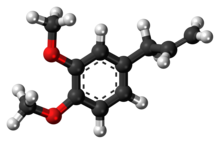
| |

| |
| Names | |
|---|---|
| Preferred IUPAC name
1,2-Dimethoxy-4-(prop-2-enyl)benzene[1] | |
| Other names
4-Allyl-1,2-dimethoxybenzene
Allylveratrol 4-Allylveratrol Eugenol methyl ether Methyleugenol | |
| Identifiers | |
3D model (JSmol)
|
|
| ChEBI | |
| ChEMBL | |
| ChemSpider | |
| ECHA InfoCard | 100.002.022 |
| EC Number |
|
| KEGG | |
PubChem CID
|
|
| UNII | |
CompTox Dashboard (EPA)
|
|
| |
| |
| Properties | |
| C11H14O2 | |
| Molar mass | 178.231 g·mol−1 |
| Density | 0.98 g/cm3 |
| Melting point | -2 °C |
| Boiling point | 254.7 °C |
Except where otherwise noted, data are given for materials in their standard state (at 25 °C [77 °F], 100 kPa).
| |
Methyl eugenol (allylveratrol) is a natural chemical compound classified as a phenylpropene, a type of phenylpropanoid. It is the methyl ether of eugenol and is important to insect behavior and pollination.[2] It is found in various essential oils.
Methyl eugenol is found in a number of plants (over 450 species from 80 families including both angiosperm and gymnosperm families) and has a role in attracting pollinators. About 350 plant species have them as a component of floral fragrance. Their ability to attract insects, particularly Bactrocera fruit flies (particularly, Bactrocera dorsalis male flies) was first noticed in 1915 by F. M. Howlett. The compound may have evolved in response to pathogens, as methyl eugenol has some antifungal activity. It also repels many insects.[3]
As of October 2018, the US FDA withdrew authorization for the use of methyl eugenol as a synthetic flavoring substance for use in food because petitioners (including the Natural Resources Defense Council, the Center for Food Safety, and the Center for Science in the Public Interest) provided data demonstrating that these additives induce cancer in laboratory animals.[4] FDA noted the action was despite its continuing stance that this substance does not pose a risk to public health under the conditions of its intended use.[5]
In European Union member states, starting in 2021, any product that contains more than 0.01% of Methyl Eugenol must contain a label to this effect this as per the CLP regulation (Regulation (EC) No 1272/2008) [6][failed verification]
See also[edit]
References[edit]
- ^ https://pubchem.ncbi.nlm.nih.gov/compound/7127#section=Names-and-Identifiers
- ^ Tan, Keng Hong; Nishida, Ritsuo (2012). "Methyl Eugenol: Its Occurrence, Distribution, and Role in Nature, Especially in Relation to Insect Behavior and Pollination". Journal of Insect Science. 12 (56): 1–60. doi:10.1673/031.012.5601. PMC 3500151. PMID 22963669.
- ^ Tan, Keng Hong; Nishida, Ritsuo (2012). "Methyl Eugenol: Its Occurrence, Distribution, and Role in Nature, Especially in Relation to Insect Behavior and Pollination". Journal of Insect Science. 12 (56): 1–60. doi:10.1673/031.012.5601. PMC 3500151. PMID 22963669.
- ^ Aubrey, Allison (6 October 2018). "FDA Bans Use of 7 Synthetic Food Additives After Environmental Groups Sue". NPR. Retrieved 14 June 2021.
- ^ 83 FR 50490
- ^ Regulation (EC) No 1272/2008 of the European Parliament and of the Council of 16 December 2008 on classification, labelling and packaging of substances and mixtures, amending and repealing Directives 67/548/EEC and 1999/45/EC, and amending Regulation (EC) No 1907/2006